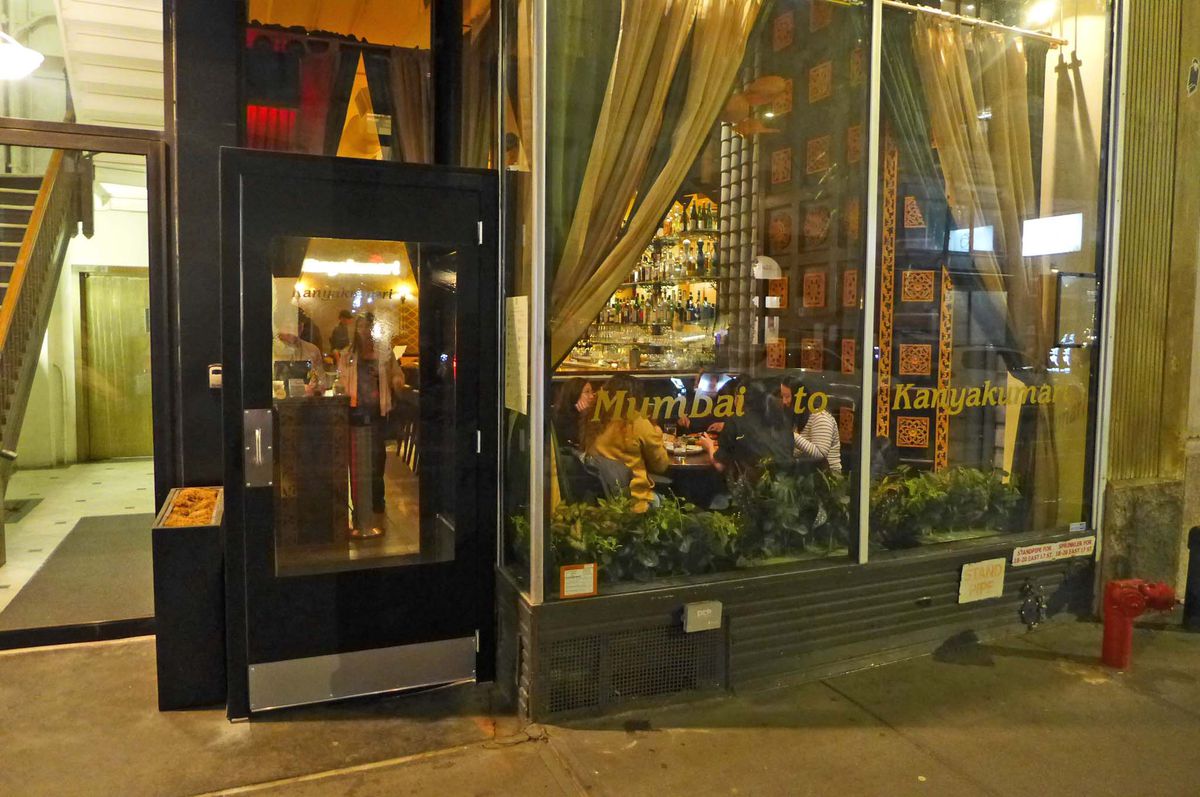Kanyakumari is a coastal town in Tamil Nadu at the southern end of the Indian subcontinent. It is also the name of Salil Mehta’s newest project — where the chef is Dipesh Shinde, who grew up in Mandad, a village 30 miles south of Mumbai. Located just off Union Square at 20 East 17th Street, the restaurant replaces Kebaya, Mehta’s short-lived exploration of a cuisine of Indonesia and the Malay Peninsula. By contrast, Kanyakumari’s menu pursues Southwest Indian coastal cooking, in a similar vein to Semma and Jazba.
I’m happy to report after a first visit that the food at the restaurant is often splendid, making it a real highlight among the Fungi Hospitality restaurants run by Mehta, which include the (formerly) Michelin-starred Malaysian restaurant, Laut, Kebab Aur Sharab, Singapura, and more.
Shinde parses coastal cuisine from Tamil Nadu to Mumbai, offering dishes from Goa, Mangalore, Maharashtra, and other maritime areas, with an emphasis on micro-regional recipes only sporadically found in Indian restaurants here.


The restaurant and bar occupy a single room, retaining such Chinoiserie elements as the patterned tiles from the previous place, while adding what appears to be a giant back-lit Buddha that dominates the room. (Kebaya’s lovely koi painting has sadly been removed.)
The menu casts itself as a journey along the coast, dividing the dishes into two confusing categories: “Beginning of Your Journey” and “Layover.” These do not correspond to conventional apps and entrees; indeed, there seems to be no indication of dish size (price is no guide, either). As with other Mehta restaurants I’ve visited, navigating the menu to get the right amount of food is a real challenge, and you usually end up ordering too much, which is perhaps the point.
Some dishes in the first category are larger than those in the second. A dish called simply “from Malabar” ($25) — citing an old name for a coastline famous for its spices — consists of a single beef rib, the meat pushed toward the center of the bone, mixed with sauteed Madras onions and heavily coated with spices. In this way the fat is hidden until you’re contentedly chewing on it, the same way it’s done in Texas barbecue.

By contrast, another dish in the same section cryptically named “from chefs special” ($15) features shrimp plunged into a rice-based idly batter, layered with peppercorns, curry leaf, Gunthur chile, clarified butter, and chutney, stylishly served in a scallop shell. Like the rib, it’s also fun to eat, and spicier than it looks. To his credit, the chef is not afraid to throw chiles and peppercorns at his customers, and judging by overheard conversations, the packed crowd around us was relishing the burn.

From Maharashtra ($26), Shinde’s birth state, comes pulled chicken in a dark and savory brown gravy laced with toasted coconut. While the amount of chicken is rather meager, the supply of gravy is copious, but what to do with it? Unfortunately, the saucy dishes at Kanyakumari come unaccompanied by starches, so you have to make some choices among the limited sides.
An order of ghee rice ($10) means your modest serving of curry will ring in at $35 or so. Alternately, there’s the wonderful neer dosa, a slippery flatbread folded like a pocket handkerchief, which is no good at scooping sauces — often the essence of the dish — so stick with the rice.

The best dish we tried that evening was a vegetarian tour-de-force of pumpkin in a tart, mustard-yellow peanut sauce that matches perfectly with the sweetness of the gourd, named “from Udipi.”


Unlike most other Indian restaurants in town, this place makes much of shellfish. “From Goa” ($22) is a handful of clams tumbled on the plate with no sauce – instead they are tossed with a “bottle masala” that tasted to me of mustard, poppy, and lemon. If your preference in bivalves runs to clams Casino, this dish will be a wonderful revelation. Meanwhile, mussels that are presented on the half shell on a bed of salt have a crust as stiff as a starched set of sailor’s whites, not softened one iota by the sauce poured over them. Thumbs down on this one.
If you are a drinker who thinks beer pairs better with Indian food than spirits, give the cocktails a spin. Using a spice indigenous to the subcontinent, “black pepper” ($18) mixes tequila and lime with a peppercorn liqueur, for a simple but effective flavor combination. “Curry leaf,” along with vodka and coconut, gives you a chance to taste this leaf quintessential to southern Indian cooking in isolation — usually it’s intermingled with a dozen other flavors.
Kanyakumari is indeed a geographic adventure, and I enjoyed nearly everything I ate there. But I wish the menu were a better guidebook, with actual descriptions of the dishes and perhaps even pictures, so you wouldn’t feel like you were taking your trip along the coastline blindfolded.
